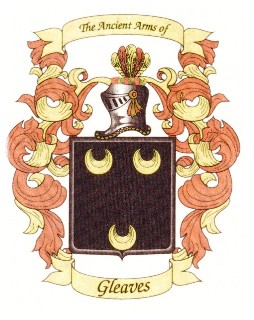- Welcome
- Family History
- Family History Research
- History of the Gleaves Name
History of the Gleaves Name

The Ancient History of the Distinguished Surname Gleaves
The chronicles of England show the early records of the name Gleaves to be derived from the Norman race. The name appears in England from about 1066 A.D., and its history is interwoven within the majestic tapestry which contains the history of Britain.
Professional researchers used such ancient manuscripts as the Domesday Book (compiles in 1086 by William the Conqueror), The Ragman Rolls, the Wace poem, the Honour Roll of the Battel Abbey, the Curia Regis, Pipe Rolls, the Falaise Roll, tax records, baptismals, family genealogies, and local parish and church records to establish that the first record of the name Gleaves was found in Cheshire where they were anciently seated as Lords of the Manor. After the Battle of Hastings in 1066, William, Duke of Normandy, having prevailed over King Harold, granted most of Britain to his many victorious Barons. It was not uncommon to find a Baron, or a Bishop, with 60 or more Lordships scattered throughout the country. These he gave to his sons, nephews and other junior lines of his family and they became known as under-tenants. They adopted the Norman system of surnames which identified the under-tenant with his holdings so as to distinguish him from the senior stem of the family. After many rebellious wars between his Barons, Duke William, commissioned a census of all England to determine in 1086, settling once and for all, who held which land. He called the census the Domesday Book, indicating that those holders registered would hold the land until the end of time. Hence, conjecturally, the surname is descended from the tenant of the lands of Highliegh who was recorded in the recorded in the Domesday Book census of 1086.
Your name, Gleaves, occurred in many references, but from time to time, spellings include Gleave, Gleve, Gleyve, Gleffe, Glefe, Glive, Glieve, Gleive, Gleaves, Glave, Glaves, Gleace, and many others. Scribes recorded and spelled the name as it sounded. It wasn’t unlikely that a person would be born with one spelling, married with another, and buried with a headstone which showed another spelling.
The Normans were commonly believed to be of French origin but, more accurately, they were of Viking origin. The Vikings landed in the Orkeys and Northern Scotland about the year 870 A.D., under their King, Stirgud the Stout, Later, under their Earl, Thorfinn Rollo, they invaded France about 910 A.D. The French King, Charles the Simple, after Rollo laid siege to Paris, finally conceded defeat and granted northern France to Rollo. Duke William who invaded and defeated England in 1066, was descended from the first Duke Rollo of Normandy.
The surname Gleaves emerged as a notable family name in the county of Cheshire where they were anciently seated. From Highleigh or High Leigh they were found from the 12th century. William Gleive was found at 1202. The name was from a spearman or lanceman. During the time of the Norman Kings there were many feudal rebellions. Many barons were attainted, traded their lands, and moved their families out of the royal influence, even into Scotland. For those interested in further research of the early history of the surname we recommend the ancient Harleian Manuscripts which are in the archives of the British Museum. These Manuscripts are a Catalogue of the Herald’s Visitations between 1510 and 1600 et.seq. Some histories go back to the Magna Carta Barons and earlier to Hastings. This distinguished surname Gleave of Cheshire is recorded in MS 1535 (fo 15) (in various folios) and others. Outstanding amongst the family at this time was the Gleave family of Cheshire.
The surname Gleaves contributed much to local politics and in the affairs of England or Scotland. During the 12th century many of the Norman families moved north to Scotland. Later, in the 16th, 17th and 18th centuries England was ravaged by religious and political conflict. The Monarchy, the Church and Parliament fought for supremacy. The unrest caused many to think of distant lands.
In Ireland, settlers became known as the “Adventurers for land in Ireland”. They “undertook” to keep the Protestant faith, occupying the lands of the Irish. As early as 1172 branches of certain family surnames moved to Ireland with the invasion of Strongbow, still more were encouraged to be a part of the Plantation of Ulster in the early 17th century. Later, the Cromwellian settlements moved other families. There is no evidence of this family surname migrating to Ireland but this does not preclude individual migration.
The democratic way of life of the New World beckoned many. They sailed aboard the fleet of sailing ships known as the “White Sails”.
In North America, migrants which could be considered a kinsman of the family name Gleaves, or variable spellings of the same family name included the name represented in many forms and recorded from the mid 17th century in the great migration from Europe. Migrants settled in the eastern seaboard from Newfoundland, to Maine, to Virginia, The Carolinas, and to the islands. From the port of arrival settlers joined the wagon trains westward. During the American War of Independence some declared their loyalty to the Crown and moved northward into Canada and became known as the United Empire Loyalists.
Meanwhile, the family name was highly regarded in the social stream. There were many notables of this name, Gleaves, embracing many notable personalities who have contributed to the society on both sides of the Atlantic.
Research has determined the above Coat of Arms to be the most ancient recorded for the family surname Gleaves.
